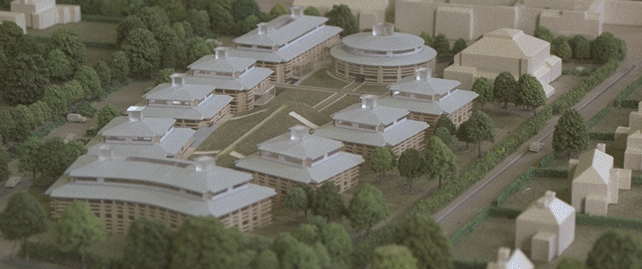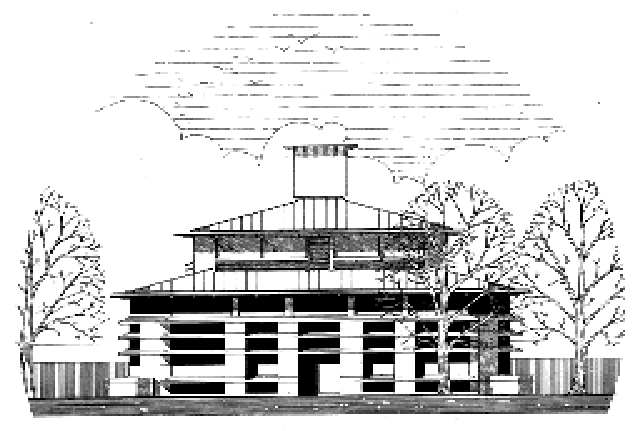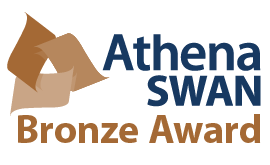Centre for Mathematical Sciences |
||||||||
NEWSLETTER • June 1997 |
||||||||
|
|
||||||||
 |
||||||||
|
A New Centre for Mathematical Sciences |
||||||||
|
ics and its applications. Together with the Centre, it will create the largest and most powerful mathematical grouping of its kind in the world. The University has given high priority to providing new buildings for the new Centre for Mathematical Sciences. Half of the £27.5 million needed to complete the project has already been raised. The Centre is one of the largest construction projects ever undertaken by the University, and has been described by the Vice-Chancellor, Professor Alec Broers, as "Cambridge's most important current initiative". Edward Cullinan Architects have prepared designs for a series of interlocked buildings in a garden setting, together with a separate library. Financial support for the move must largely come from external benefactions. Support from the Astronomer RoyalOne of those who have been active with the fund-raising is Sir Martin Rees, Britain's Astronomer Royal since 1995. The post of Astronomer Royal, chosen by the Queen, dates from the seventh century and until about 25 years ago it carried with it |
||||||||
|
Cambridge University has been a centre of mathematical excellence since the time of Sir Isaac Newton, but the Faculty of Mathematics, now larger and more active than ever before, is a victim of its own success. Faculty and student numbers are three times what the present Mathematics buildings on Silver Street and Mill Lane were designed to accommodate, resulting in a severe shortage of teaching and research space. The University has therefore decided to create a new Centre for Mathematical Sciences on a seven acre site in Clarkson Road, within walking distance of central Cambridge. The Centre will accommodate: The Department of Pure Mathematics and Mathematical Statistics The Department of Applied Mathematics and Theoretical Physics The Isaac Newton Institute for Mathematical Sciences. The Newton Institute was set up four years ago as the UK's first international research institute devoted to stimulating new advances in mathemat |
||||||||
|
the duty of directing the Royal Greenwich Observatory. In recent years, however, it has been a purely honorary title. The only previous Cambridge-based Astronomer Royal was Sir Martin Ryle, the radio astronomer. Sir Martin Rees, who holds the Royal Society Research Professorship in the University's Department of Astronomy, and recently played his desert island discs on BBC Radio 4, says of the proposed move: Mathematics is pivotal to science and technology. A substantial fraction of the country's mathematical talent is educated at Cambridge. The departments have a strong international flavour, and tradition of lively collaboration, and an enviable concentration of distinguished names. It's hard to think of anywhere in the academic world that is so cost-effective in generating creative and fruitful ideas. When I did my PhD in mathematics, in the 1960s, the |
 |
||||||
| departments had just moved in to `temporary' buildings. It would be really splendid if, after 30 years of growth, they had a real chance of occupying an imaginatively-designed complex of buildings on a fine new site. | |||||||
|
Charles Corfield — Gift of £2.5 Million "If anyone doubts the value of mathematics, I hope that seeing a businessman part with hard-earned dollars will convince them." Charles "Nick" Corfield graduated from Cambridge with a mathematics degree in 1982. Corfield decided to become a software entrepreneur and moved to California where in 1985 he founded Frame Technology Corporation, whose flagship product FrameMaker became the market leader in technical publishing. Adobe Systems acquired Frame in 1995, and since the take-over Corfield has devoted himself to other technology start-ups in Silicon Valley, and to Cambridge. Corfield serves on the Centre for Mathematical Sciences Advisory Committee and has pledged £2.5 million to the Cambridge University Development Office in the United States, with the hope it will advance the University's development plans. Said Corfield on making his pledge: "Mathematics is fundamental to mankind's progress and Cambridge can identify itself as a centre of excellence in the mathematical sciences. I am proud to be able to help the University create a productive working environment that will promote interactions essential for modern mathematical teaching and research." |
Gift from the Märit and Hans Rausing Charitable Foundation News has just been announced of a £2.5 Million donation to the new Centre for Mathematical Sciences from the Märit and Hans Rausing Charitable Foundation. Swedish born Hans Rausing was managing director and, later, chairman of the Tetra Laval Group for 37 years. He and his wife, Märit, farm in Sussex and Kent. Hans Rausing's main interests today are investments in, and the development of, Russia and the Ukraine, and theoretical science, especially cosmology. Therefore the new Märit and Hans Rausing Building will be the accommodation for the new Institute of Theoretical Physics. |
||||||
|
American Friends Advice for American citizens on tax-efficient giving to the University may be obtained from Kathleen Foley at the New York office of the American Friends of Cambridge University (212 880 2840). |
|||||||
|
Current Research in Cambridge The new Centre will provide modern facilities for Cambridge's world-class research, which is unrivalled internationally in all areas of mathematical science, from cosmology to number theory. The Centre has been designed to advance this research by providing precisely the combination of privacy and opportunity for interaction and discussion which is essential for successful mathematical study.
In this series of regular newsletters, we will ask some of our premier researchers to update readers on some of the work currently being undertaken in the Faculty — work that will be greatly advanced by the development of the new Centre. Anne-Christine Davis:The First One Tenth of a Second Anne-Christine Davis is the only woman Reader in the Mathematics Faculty. She works at the interface of cosmology and particle physics. Whereas Steven Weinberg described "The First Three Minutes" in the evolution of the universe, Anne-Christine Davis examines the first one tenth of a second. The moment of creationAs we move back in time towards the Big Bang the universe becomes hotter and denser until the first of a sequence of phase transitions occurs. The Universe began in a very simple (unified) phase and then passed through various phases until, at lower temperatures, the present complicated structure of matter was obtained. The early universe can be viewed as a vast high energy physics laboratory in which all the processes of interest to particle physicists must have occurred. Looking at the structure of fundamental interactions shows that matter is composed of elementary building blocks, quarks and leptons. Protons and neutrons consist of quarks, and the family of leptons includes electrons. The two key concepts of unification of the fundamental forces and phase transitions are vital to our present understanding of particle physics. Topological DefectsThese phase transitions have profound implications for the evolution of our universe. There is a possibility in cosmology that there are so-called |
|||||
|
A Responsive Architect Edward Cullinan Architects have been commissioned by Cambridge University to plan the development of the new Centre for Mathematical Sciences on the Clarkson Road site. Ted Cullinan studied Architecture in Cambridge and spent his spare time designing sets for May Balls. The earliest Cullinan building was developed at around this time - he constructed a garden shed for his aunt! After Cambridge he went to the Architectural Association School in London. His first real project was the re-creation of the remains of a Bell Tout Lighthouse in Sussex, bought for him by his father. Next came a year at Berkeley, which he describes as "the most thrilling time of my life." Back in England in 1958, Cullinan started to work for Denys Lasdun on projects such as Fitzwilliam College, Cambridge, the extension to Christ's College, Cambridge, and the new University of East Anglia, in Norwich. In 1965 he began teaching in the Department of Architecture in Cambridge and taking on independent commissions. Cullinan's first projects were houses, e.g. Highgrove, for Hillingdon Council. The Minster Lovell Conference Centre, in the Cotswolds, was the first of Cullinan's buildings to achieve critical attention as a model of the marriage of old and new. In 1975 it received the "European Architectural Heritage Year" Award. Cullinan has been involved in many high profile projects including: Leeds Playhouse (1985) Lambeth Community Care Centre (1980-85) Royal Opera House, Covent Garden (1984) Fountains Abbey Visitor Centre (1987-92) The Library of St John's College, Cambridge (1990-93) In 1992 he expanded his work overseas with developments in Tama Forest, a Japanese National Park, and at the University of North Carolina, Charlotte. Following work carried out for The English Heritage at Fountains Abbey, Edward Cullinan Architects were invited to build the new Visitor Centre at Stonehenge (1992-96). |
|||||
|
topological defects left over from the hot early stages of the universe which would appear as domain walls, cosmic strings, monopoles or textures. These defects present a number of different scenarios for creating the primordial fluctuations in matter density which seeded galaxy formation. Cosmic strings are filaments, with regions in the symmetric phases, perhaps trapped in their core. The influence of these on the galaxy formation and on the imbalance between the numbers of protons and antiprotons can be investigated. Looking for EvidenceExperiments to demonstrate these effects cannot be carried out as the temperatures in the early universe are too high to replicate, so we have to look for evidence in the traces left over. Possible evidence of these topological defects may exist in the cosmic background radiation. SatellitesExperiments carried out using satellites show the variation in the microwave background radiation; which may indicate what happened at the birth of the universe. |
Such experiments have been carried out with the American Cosmic Background Explorer (COBE) space satellite with exciting results. However, to distinguish between different cosmological theories needs the increased sensitivity of future experiments. Cosmic strings, left over relics of high density from the very early universe which serve as gravitational seeds for the growth of structure, will leave their imprint in the cosmic microwave radiation in the form of temperature fluctuations. By analysing the temperature fluctuations in the microwave background cosmologists can test and probe the universe as it was immediately after the Big Bang. SupercomputingAnalysis of the data is carried out using the massive computing power now available in Cambridge. As well as the new Hitachi Supercomputer, Cambridge have also recently obtained a "Cosmology" computer which is used in collaboration with Imperial College (London) and the University of Sussex. |
|||||
Comments from the Heads of DepartmentsThe American Friends of Cambridge University have produced an audio tape with speakers from the Faculty of Mathematics talking about the diverse areas of research in Mathematics and pointing towards the development of a new Mathematics Centre in Cambridge. Here are extracts from the comments made by the Heads of Departments. "I think our strongest point as a Mathematics Department on the world scene is that we have always produced some of the most original and gifted young mathematicians in the world." John Coates, Sadleirian Professor of Pure Mathematics "Applied mathematics looks at the problems of scientific importance in the day-to-day world as we know it." "The new Centre will greatly facilitate interactions within mathematics and between mathematics and other disciplines." David Crighton, Professor of Applied Mathematics The Cambridge Mathematics audio tape is available free of charge from Peter Landshoff, The Department of Applied Mathematics and Theoretical Physics, Silver Street, Cambridge, CB3 9EW. Please mention that you heard about the tape through the newsletter of the Centre for Mathematical Sciences (June issue). |
||||||
|
Research Programmes at the Newton Institute The Isaac Newton Institute for Mathematical Sciences is an international research institute for the mathematical sciences. It will form part of the Centre for Mathematical Sciences on the Clarkson Road site. Current programmes at the Institute are: Representation Theory of Algebraic Groups and Related Finite Groups, January to June, 1997. Organisers: M Broué (Paris), R W Carter (Warwick) and J Saxl, (Cambridge). Non-Perturbative Aspects of Quantum Field Theory, January to June, 1997. Organisers: D Olive (Swansea), P Van Baal (Leiden) and P West (King's College, London) During the university term the Institute holds a series of talks aimed at a general scientific audience which are open to all. Details can be found on the Institute web pages at |
||||||

